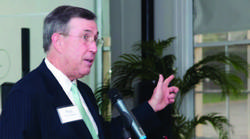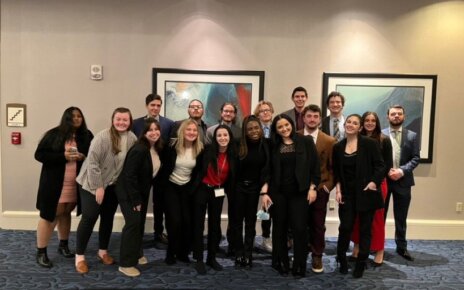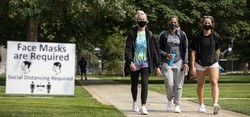Involved, strong and outward.
Those are the adjectives that President Paul G. Gaffney II used to describe his time at the University. After nine years of service, Gaffney announced on Monday his decision to retire following the next academic year in June 2013. When he steps down, Gaffney will have fulfilled a decade of service as University President.
“I’ve come to the realization that there’s a point in your life when you’ve made about as much progress as you think you can make,” Gaffney said. “I sense that an institution like this needs new and different ideas. It’s healthy for the University.”
Robert Sculthorpe, Chairman of the University’s Board of Trustees since 2010, has served on the Board since Gaffney became President in 2003. “I think [Gaffney] generally feels that 10 years is about the right time because he has spent a lot of energy, a lot of creativity, a lot of ideas,” Sculthorpe said. “He feels very fulfilled as he said in his remarks that he and Linda both leave completely satisfied with what they’ve contributed to Monmouth.” Linda Gaffney has been married to Paul Gaffney for 37 years. “My husband and I made a joint decision before we arrived at Monmouth University that his second career should span a maximum of 10 years,” she said. “We think [that] each university president brings new ideas, philosophies, abilities and talents to the table. At the end of 10 years, all those new and exciting elements should be renewed and it would be time for the next chapter in our lives, as well as Monmouth’s.”
Challenges
After finishing a threeyear presidential term at the National Defense University in Washington, D.C., Gaffney became the University’s seventh president in July 2003. Since taking office, he said that his hardest challenge has been improving the University’s relations with its surrounding towns.
“I had been the president of a university and I’ve been to most of the major universities in America over the last 20 years,” Gaffney said. “So nothing here really surprised me, even though I wasn’t a fulltime administrative educator my whole life, but I was surprised by the towngown relations.”
Gaffney’s work on town-gown relations has been noticed by the Board. “I think [Gaffney] proactively went out to tell the University’s story and make it a point that we are not adversarial with the community, [but] that we are an asset and that we’re good citizens,” Sculthorpe said.
Two common town-gown concerns include zoning and planning approval for on-campus construction projects, and underage drinking policies. Gaffney said that he expected the latter because it is a common issue at many colleges and universities. However, he was surprised at the amount of time and money spent on seeking zoning and planning approval from local towns. Since 2003, the University has made the most progress in its relations with the townships of Long Branch and Ocean, Gaffney said.
“Working on bettering the relations so that the towns trusted that we were doing the best we could in both of those cases was a major challenge for me and it’s something I’m still working on,” Gaffney added. “I think we made a lot of progress.”
Adam Schneider has been the mayor of Long Branch for nearly 22 years. He commented that Gaffney has always been great to work with during the latter’s 10 years as University president.
“There was always a lot of contact,” Schneider continued. “I see him frequently.”
When it comes to zoning and planning issues, Schneider said that Gaffney has always addressed him before the beginning of any construction projects via phone call or visit.
In the last few years, Gaffney worked with the local towns to build the Multipurpose Activity Center and Mullaney Hall, expand Edison Science Hall and upgrade the art building. Future construction plans include adding to the Leon Hess Business School, Gaffney said.
Besides town-gown relations, Gaffney added that he worked to popularize the University. Upon taking office, he was surprised that more people had not heard of the University given the beauty of its campus, safety of the surrounding towns, and its proximity to the beach and major cities.
“I said the University also has to have some influence and be seen outside the fence,” Gaffney commented. “I think a lot more people know about Monmouth University now than 10 years ago.”
Notable Contributions
One of the biggest contributions that Gaffney has made to the University as its president is his record of perfect attendance, he said. “I love being on the campus,” he explained. “I love being out of my office.” Gaffney said that his fondness of the campus has led him to be accessible to the University community. “I’m pretty proud that I’m known and approachable around the campus,” he continued.
Sculthorpe added that he often noticed the exchanges between Gaffney and students when the two walked around the campus. “It’s just amazing how many students he knows by name,” Sculthorpe said.
Besides being consistently visible outside of Wilson Hall, Gaffney added that construction played a major part in his presidency. Many such projects were made possible through Gaffney’s fundraising skills that helped bring in federal money, such as $10 million for the Rapid Response Institute.
Also since 2003, the academic quality at the University has grown with the increasing grade point average of each incoming freshman class; this number rose from 2.98 during the fall of 2004 to 3.4 during the fall of 2011. Despite the improvement in this area, Gaffney highlighted the relatively low cost of the University compared to other private institutions in New Jersey. For instance, Seton Hall University has an annual fulltime undergraduate tuition cost of $33,490, while the University’s is $28,000.
“I think Paul has delivered and over-delivered in many ways,” Sculthorpe said. “Anything he has recommended, anything he has suggested, anything that he is involved with – he gets it done.”
Dr. Rebecca Stafford, who preceded Gaffney as the sixth president of the University for 10 years, said that Gaffney met the challenges that she left for him and more. “Of course, we always leave challenges for our successor and I left him plenty to improve, [such as] our fundraising, finances and the academic quality of the school,” she said. “That’s been amazing; we’re now listed in The Princeton Review and a lot of other publications, so we have improved that academic quality and reputation, and he did that.”
Desire to Do More
Despite a long list of accomplishments, Gaffney said that there are still areas in which he wishes he could have contributed more as University president. “I think I could stay here 20 years and everyday there’d be something I’d see that I’d want to make better,” he said.
Stafford said that the sciences were an area that she left as a challenge for Gaffney when she departed in 2003. “I would like to see more emphasis on the sciences,” she said. “There’s an infinite room for growth and development.”
As a scientist and engineer, Gaffney said that he agrees with Stafford’s limitless vision for the sciences. He considers that area to be the University’s primary area for raising and spending money. By expanding Edison Science Hall this past year, Gaffney said that this enables the growth and modernization of science laboratories.
Gaffney also helped create two institutes that strengthened the University’s science program. The Urban Coast Institute is a science and policy institute that examines issues surrounding the coast in an urban environment, such as New Jersey. “We did that because I’m an oceanographer, we’re so close to the beach and we had no oceanography program,” Gaffney said. “We weren’t going to build ships and piers and big laboratories like Rutgers and Stevens have. We wanted to find a niche and this we could do without having to spend zillions of dollars.”
The other program developed during Gaffney’s presidency is the Rapid Response Institute. Gaffney said that he sought to build upon the University’s nationally recognized software engineering school which helped him raise millions of federal dollars for the institute.
Aside from growing the University’s science school, permanent seats for soccer games and two more off-campus residence halls that can accommodate 800 students in the West End section of Long Branch were two other tasks that Gaffney said he would have liked to conquer.
Challenges for the Next President
Jersey’s other private institutions], but we’re in the bottom third.” Even so, Gaffney said that any increase in tuition will take place gradually in the coming years.
As far as increasing enrollment goes, Gaffney said that that has become a challenge for any college or university in the Northeast. This is due to a decline in the region’s number of 17 and 18yearolds who are eligible to attend college. “It has nothing to do with me or Monmouth University, but it’s a challenge that the new president is going to have to face,” Gaffney said.
Pondering a Replacement
As the current University president, Gaffney will have no say in who replaces him. However, he still speculated as to the type of person needed to fill his shoes. While he said that the best fit for the University would be an individual with a combination of business and academic exposure, Gaffney admitted that he can see a wide array of backgrounds filling the presidency.
“I could see a lawyer, a businessman, a former military person, a professor who has had no administrative experience [or] somebody who has been in higher education his or her whole life,” Gaffney said. “It’s really going to depend on the personality and whether it’s apparent when they interview that they’re really going to love being at Monmouth University.”
Regardless of what background the next president comes from, Gaffney said that he or she must embrace the education mission. “He’s got to know that he’s around 6,000 students every day,” he said. “You’ve got to love this job because it’s 80 hours per week.”
“We knew this would not be an eight hour, five-days-a-week position when Paul signed his first Monmouth University contract,” Linda Gaffney said. “I would conservatively guess my husband spends an average of 12 working hours on weekdays with university and community affairs. We seldom have a free weekend due to athletic and other MU socially related events. There are never enough hours in a day, a week or a year for a university president.”
Paul Gaffney speculated that there are going to be major changes in the field of higher education during the next decade, which may even include mergers and acquisitions among colleges and universities. He said that someone who is interested in these types of financial opportunities might make for a good president.
Above all, the next president needs to be somebody who can move quickly and in different ways, Gaffney said. “Universities change very, very slowly,” he added. “My guess is that’s going to be different in the next 10 years. You’re going to have to move a lot more quickly to stay in business, to stay competitive.”
Post-Retirement Plans
Following retirement, Gaffney said that he is still unsure of what he wants to do or where he wants to live. He added that he and his wife agreed to hold off talking about future plans until this coming summer.
As far as his relationship with the University is concerned, Gaffney said that he hopes to remain in contact. However, he added that he plans to keep his distance as he has done after leaving previous jobs so that his successor can grow. “I would want to be as supportive of the University and help however I could, but I don’t want to be in the hair of the new president,” Gaffney said. “I think that’s unfair to [him or her]. [He or she] needs to be judged [alone], not compared to me.”
PHOTO COURTESY of Jim Reme



